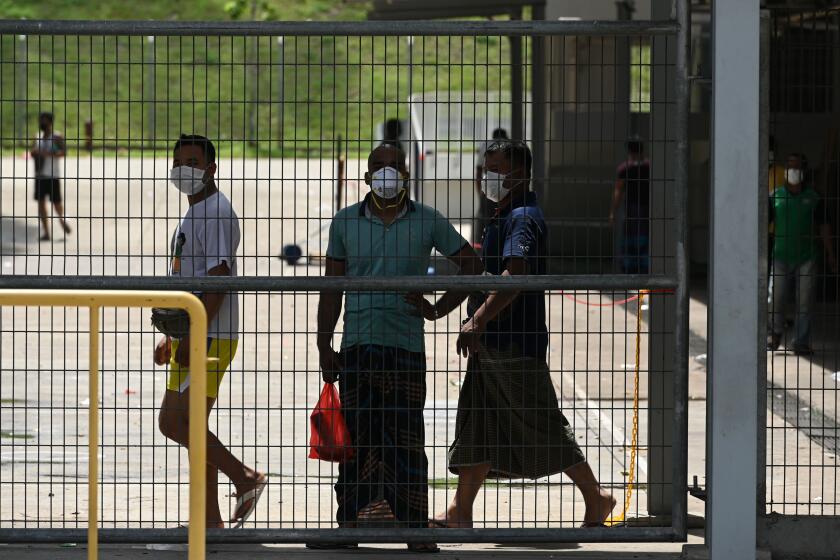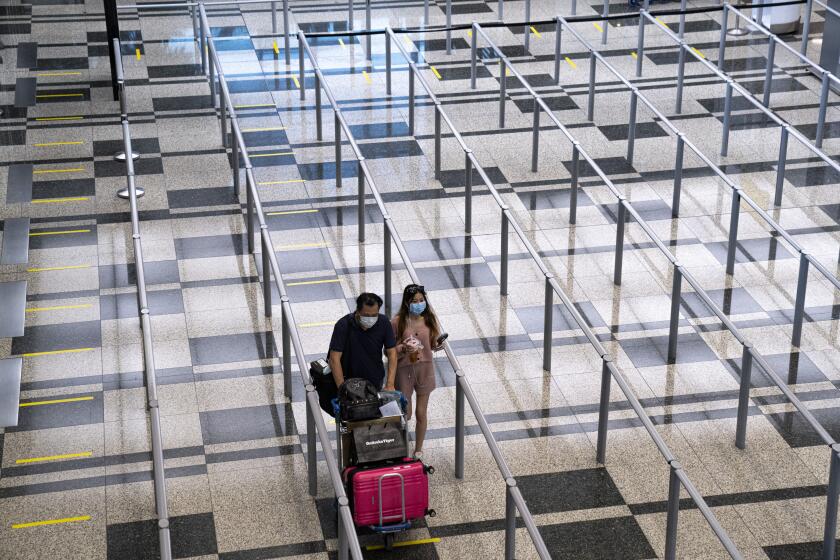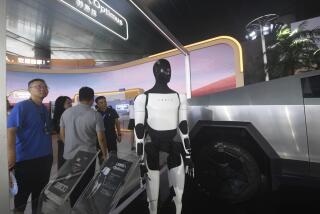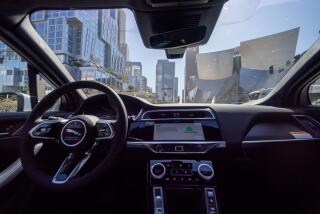Singapore enforces social distancing — with a robot dog
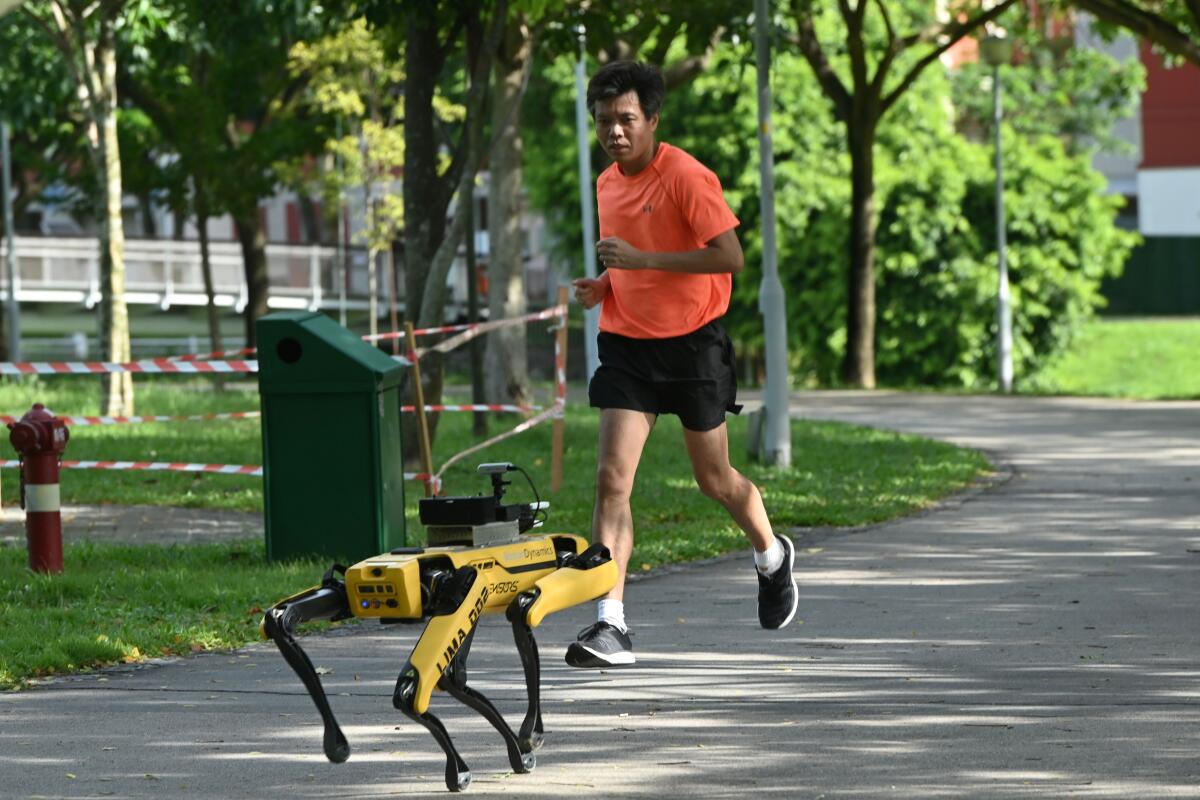
- Share via
SINGAPORE — Leaves crunch underfoot as Spot marches through the park, back straight as a tabletop, stride brisk as a soldier’s.
A grassy field encircled by trees beckons. But Spot is focused on the asphalt path ahead, where a few joggers and bicyclists are out for some socially distanced sunshine.
For the record:
7:11 a.m. May 14, 2020An earlier version of this story misstated the owner of Boston Dynamics. It is Japanese conglomerate Softbank, not Google parent company Alphabet.
A cyclist in a brimmed hat rides past. Spot pipes up, not with a bark, but with a recorded message.
“Let’s keep Singapore healthy,” comes a woman’s voice, polite but firm. “For your own safety, and for those around you, please stand at least one meter apart. Thank you.”
Spot, clearly, is no ordinary squirrel-chasing canine. It’s an agile, four-legged, arrestingly doglike robot that Singapore has deployed to help enforce distancing measures during the second month of a partial coronavirus lockdown.
Developed by Boston Dynamics of Waltham, Mass., Spot is one of the world’s most advanced commercial robots, last seen opening doors, hauling a truck or dancing to Bruno Mars in a slate of mesmerizing promotional videos. Its two-week pilot in a park here is seen as a test of how machines and artificial intelligence could help reduce human contact in public spaces as some governments begin easing social restrictions.
“The world is watching to see what happens with the Spot trial,” said David De Cremer, a Belgian scholar and director of the Center on AI Technology for Humankind at the National University of Singapore. “It’s a glimpse of the future.”
The semiautonomous Spot, which can walk up to 3 mph over uneven terrain, detect obstacles with 360-degree vision and get up after it falls, captures the promise and terror of a mechanized future in which robots assist in human tasks — or replace them altogether. Its whirring joints and eerily precise prowl inspired an episode of the dystopian British TV series “Black Mirror,” which envisioned a breed of human-hunting robot dogs.

Spot is seen in a 2018 video from Boston Dynamics.
When Spot became available for lease last September, its first applications included inspecting construction sites and utility installations, cluttered environments dangerous for humans. It also got a three-month trial as an “observation device” on the Massachusetts State Police bomb squad.
But as the COVID-19 pandemic forces societies to reconsider even routine human interactions — exercising in a park, weaving through a grocery aisle, getting your vitals checked at a hospital — machines are being pressed into a new range of tasks.
In several countries, aerial drones are transporting medical samples, spraying disinfectant and delivering food and medicine. A fleet of wheel-mounted Danish robots is stationed in hospitals across China, sanitizing rooms using ultraviolet light.
Last month, Brigham and Women’s Hospital in Boston began using Spot to help screen patients outside the entrance, using an iPad mounted on the robot that displays a physician inside the facility. The trial has limited the medical staff’s exposure to infection and helped conserve protective gear, said Michael Perry, Boston Dynamics’ vice president of business development.
“It’s a validation of the core premise of robotics: You’re taking an environment where data collection or interaction with a physical space is too dangerous for a person to do, and putting a robot in their stead to do a simple, repetitive task,” Perry said.
Singapore, a prosperous island nation of 5.7 million people grappling with one of the highest COVID-19 caseloads in Asia, is using a fleet of 30 drones to monitor crowd levels in public parks, which have remained open during a lockdown that began in early April.
New infections among Singapore’s migrant workers offer a stark illustration of the risks to marginalized groups in densely inhabited parts of Asia.
Thousands of “safe distancing ambassadors” have also fanned out across parks, malls, markets and other public areas.
Their presence has not always been welcomed: Last week, a parks officer was stabbed in an altercation with a man who was illegally cutting plants while not wearing a mask. The officer is recovering after surgery; his assailant has been arrested and charged with attempted murder.
Singapore officials said the goal of using Spot was “reducing the manpower required for park patrols and minimizing physical contact among staff, volunteer safe distancing ambassadors and park visitors.”

Painted safety yellow — the color of construction vehicles — the robot is accompanied by a parks officer at the 150-acre Bishan-Ang Mo Kio Park. Its recorded message reminds people to maintain social distance.
Cameras installed on its body will help estimate the number of visitors in the park, but officials said they cannot recognize individuals and won’t collect any personal data.
If the trial is successful, officials said they would consider deploying Spot for longer hours and at other parks. A second Spot robot has also been in use since last month to deliver medicines at an isolation facility housing thousands of COVID-19 patients.
Spot has been greeted with a mixture of marvel and trepidation. One video showed a real dog staring at Spot in apparent confusion.
Critics outside Singapore described it as “creepy” and “frightening.” One tweeted: “Can’t wait until they’re fitted with tasers for non-compliance.”
But Spot is not driven by artificial intelligence: Most of its movements are directed by remote control, and it’s designed to evade anything in its path taller than a foot. The roughly 130 robots in use around the world — leased to customers for several thousand dollars a month — come with agreements that they not be used to harm or intimidate, according to Boston Dynamics, which is owned by the Japanese conglomerate SoftBank.
Singapore is an amenable testing ground: Its ruling party, in power for more than half a century, enjoys high public trust, encourages tech innovation and muzzles dissent. The government has developed an app to trace people who’ve been in contact with COVID-19 patients and is considering making its use mandatory, dismissing concerns about official surveillance.
TraceTogether’s app launch comes as concerns over privacy and intrusive surveillance are rising as governments try to curb the pandemic.
“I do think the balancing of social interests and civil rights is shifted in an emergency toward favoring technologies that can help address the emergency,” said Kristen Thomasen, an expert in robotics law and policy at the University of Windsor in Ontario, Canada. “When this happens, though, one of the most crucial things to look for is clear government indication and imposition of limits on the use of the technology.”
Already, Singapore engineers are designing algorithms that could make Spot more sophisticated, De Cremer said. One idea is to log distances between parkgoers and the lengths of their interactions to determine whether people are together in a group or strangers passing on the grass.
That could help enforce social distancing, but over time it could also teach a robot to read some physical aspects of human relationships.
It’s just one way that the pandemic will serve as a laboratory for the near future of machines, De Cremer said.
“These trends are going to be accelerated,” he said. “And decisions on the boundaries and limitations of robotics and AI are going to depend on a society’s values.”
More to Read
Sign up for Essential California
The most important California stories and recommendations in your inbox every morning.
You may occasionally receive promotional content from the Los Angeles Times.
